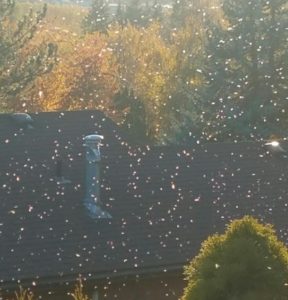
It’s not snowflakes, it’s aphids flying about parts of the Northwest
Listen
(Runtime 1:01)
Read
No, that’s not snowflakes you’re seeing on these sunny fall afternoons. It’s clouds of smoky-winged ash aphids that showing up in the Northwest, floating through the air like drifting snow or ash falling from wildfires.
“Take a walk at 5 or 6 in the afternoon, and you’ve really got to keep your mouth shut,” said Richard Zack, an entomologist with Washington State University.
Coming back from a walk can require picking the tiny bugs out of your hair and rubbing them from your eyes, he said.
However, besides being a bit annoying, these massive swarms of aphids aren’t harmful, Zack said. In fact, the aphids that die could be feeding birds and frogs, he said.
“Insects are amazing, and we don’t often see them,” Zack said. “This is one of the times when they really kind of show themselves.”
The bugs are on a migration they take every year, just en masse. The tail end of this fall’s warm weather is extending the flight season for the aphids, he said.
“They seem to be persisting because of this kind of fabulous fall that we’ve had,” Zack said.
The smoky-winged ash aphids have spent a flightless summer sucking up root juice from conifer trees. Now, “clouds and clouds and clouds” of bugs are flying to lay eggs in the bark of ash trees, Zack said.
“Their normal summer plant is going to die or disappear, so they need to go someplace. This is the extreme example of that,” he said.
The bugs should disappear as the temperatures drop, he said.
“Of the literally millions of them that are out there, very few will actually make it,” Zack said.
This year’s spectacular aphid bloom could be a yearly sighting that could happen more often as the climate warms, he said.















